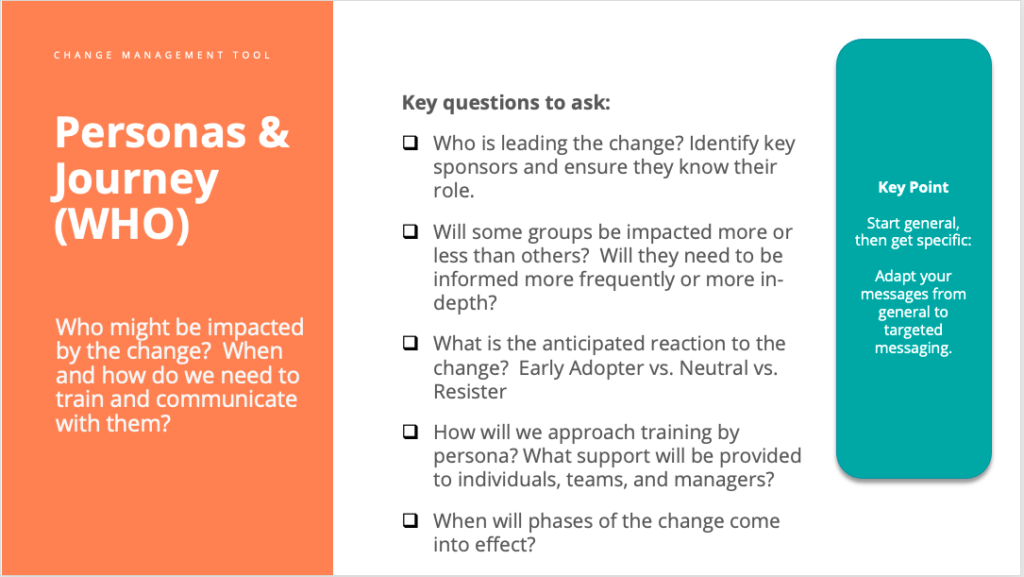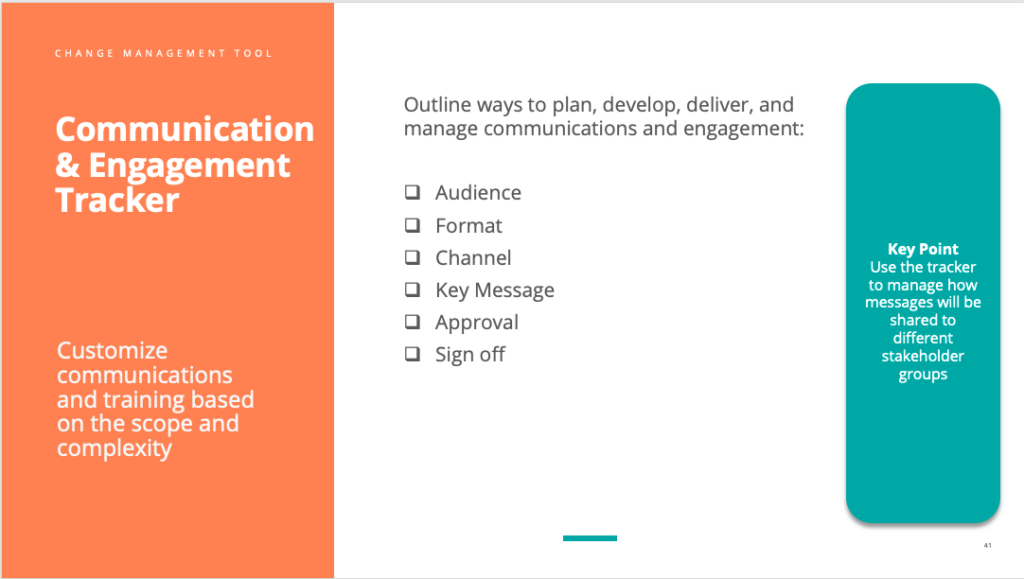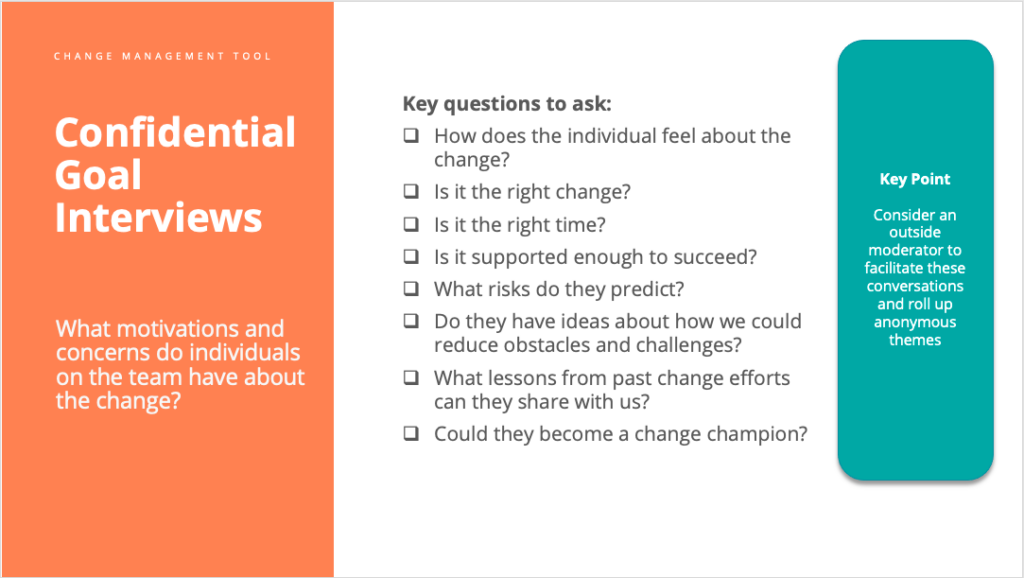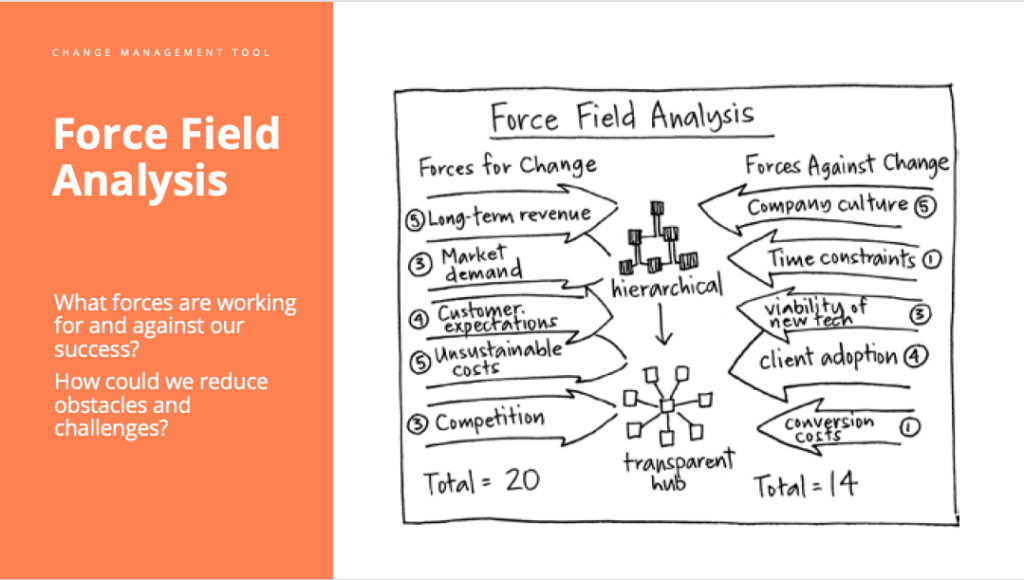You learn about a C-suite decision that will have a transformative impact on your content marketing team. Perhaps, the announcement included one or more of these directives:
- “We must produce more content and manage multi-platform distribution with greater agility. We plan to add ChatGPT to our editorial capabilities and implement a headless CMS.”
- “We’re updating our three-year business strategy and need all teams to align their operations around achieving a new set of goals.”
- “We’ve been acquired. We will be merging many of our business units and will need to relaunch our website so we can tell a more unified story.”
Or maybe it’s another substantive shift in strategy or operations. As a content team leader, whether excited or terrified, you must get your team on board and ensure the initiative succeeds.
Transformational changes are nearly impossible to implement without a clear plan that communicates the desired destination, the motivation to pursue it, and the path to reach it.
To build that plan, follow this step-by-step guide from Jenny Magic, which she co-developed with Melissa Breker.
5 sabotages that disrupt transformational changes
Every organization has unique conditions and challenges, but Jenny points out five common barriers that prevent the successful adoption of new priorities and practices:
- Forced change. When workers don’t understand or agree with the change, they won’t invest in the process, especially if it requires a lot of effort or a long-term investment.
- Misaligned goals. You can’t sell a change that benefits the company if employees don’t see how it helps them reach their personal or professional goals.
- Group-speak. Your team may nod in agreement when the CEO says, “We’re all going to do this together, right?” But that enthusiasm might not hold when the boss’ eyes are no longer on them.
- Rushed process. Team members already overwhelmed with responsibilities don’t give new tasks top priority. Jenny says if you can’t take something off their plate, communicate they won’t be pressured to rush it through.
- Lack of team alignment. Everyone must be on the same page regarding the direction, intention, and actions required. Without this alignment, tasks fall through the cracks, and all the hard work may not lead to achieving the goal.
For your change mission to succeed, your communications plan should account for how you’ll address (or avoid) these obstacles. These details will minimize the friction, lack of participation, and flagging enthusiasm you could have experienced during implementation.
Plan for the transformation journey
Jenny shares a three-part approach she uses to help her consultancy clients get big ideas off the drawing board, onto team members’ priority lists, and into the marketplace.
1. Establish the destination: What’s changing, why, and what’s involved
To get your team to join the journey of change, they need to know where they’re going. Create a change summary to help with that. The simple map summarizes the relevant details about the change, the phases of implementation, and the benefits gained when the goal is reached.
First, identify the most critical details to communicate. Answer these questions:
- What’s the nature of the change? What is being done differently, and what does that mean for the business and team? What isn’t changing that might be the stability anchor?
- Why is it happening? Why does the organization think this change is critical? Why is now the right time to do this?
- Who’s involved? Who will the change affect? What will they be expected to do? What about their roles, processes, and priorities? Why would they want to participate, and why might they be reluctant?
- When will it happen? Will the change occur all at once or gradually? What happens at each stage, and which ones will require the content marketing team’s involvement?
- What are the expected results? What is the organization looking to achieve? What benefits or advantages will it bring? What will the company and team see when the goal is reached?
With these answers, you can build a change summary to share in stakeholder and team member conversations. Any spreadsheet or presentation tool will do, though you can create a template based on the document Jenny uses for her client engagements (below).
The summary of what’s changing appears at the top of the page and details of the most critical elements appear below it. Bulleted notes detail what to expect with each element and the benefits for the business and your team. Lastly, a general timeline outlines each project phase.
2. Load up the crew: Gather support and communicate benefits
To achieve the change goal, all players must agree to travel together and move in the same direction. “If our team is not aligned on where the heck we’re going, there’s literally no chance we’re going to get there,” Jenny says.
Team members who immediately see the value in the initiative might follow your lead without question. But some key players may need a little more convincing. Jenny offers a few ideas to get them on board.
Enlist the support of an active, visible sponsor: Social media shows putting the right influencer behind your pitch can move minds. The same goes for pushing through a big change within an organization. Research from Prosci finds projects with an extremely effective sponsor met or exceeded objectives more than twice as often as those with a very ineffective sponsor.
If you have the support of senior team leaders and high-profile company personnel, ask for their help socializing the change to others. They might seed relevant information in their newsletters and other content they share internally or help shape your change activities and messaging to improve their appeal.
Translate organizational goals into personal motivations: Some team members may reluctantly participate because they perceive an impact on their role. For example, workers may think the added work will strain their already demanding schedules. Others may be skeptical because of negative experiences with similar changes in the past or disbelief that the change might benefit them.
A series of stakeholder conversations can help identify the significant concerns and disconnects that might prevent them from engaging. They also can reveal specific challenges and motivations that you can address with more resonant and appealing messaging.
Some marketing tools you use to influence an audience can help you facilitate those conversations. For example, Jenny says, personas can surface critical insights about who may be impacted by the change and what it might take to nurture them onto the path.
Her personas checklist includes these questions:
- Who’s leading the change? Do any key sponsors directly relate to the persona’s role?
- Will this persona be impacted more or less than others?
- Will they need information more frequently or in greater detail?
- What reactions will they have?
- How will you approach training for this persona? What support will be provided?
- At what phase of the change will they be most affected?
Jenny also recommends using your marketing communication and engagement tools. For example, the simple tracking sheet she developed (below) can help visualize the audience, delivery formats and channels, optimal messages, and approval and final sign-off requirements to mention in your stakeholder discussions.
Choose the right messenger – and a customized message: Sometimes, a disconnect occurs not because of the message but because of the message’s deliverer. For example, employees expect to hear about significant corporate initiatives from executives and senior leaders. But for changes impacting their day-to-day responsibilities, they may prefer to hear from a manager or supervisor who understands their role.
Other times, preventing a disconnect could require tailoring the message to the team’s needs. Jenny suggests focusing on the direct benefits once the initiative is activated. “Consider how it might help them further their career, address something they’re struggling with, or offer an opportunity to explore an area they’re passionate about,” Jenny says.
Surface hidden issues with confidential interviews: Valid concerns can remain hidden, especially for team members who are reluctant to voice their objections in team meetings. Working one-on-one with a neutral or external moderator – someone with no stake in the decision for change – might help them open up.
Ensure they know the confidential interview results will be aggregated so no individual responses will be identified. “It’s really helpful to get that confessional energy,” Jenny says. “It can help you surface individual reservations, causes of their reluctance, and personal motivations. “
Jenny shares in her checklist (below) some preliminary questions for a moderator to assess during a confidential interview:
- How does the individual feel about the change?
- Is it the right change?
- Is it the right time?
- Is it supported enough to succeed?
- What risks do they predict?
- Do they have ideas about how we could reduce obstacles and challenges?
- What lessons from past change efforts can they share with us?
- Could they become a change champion?
The process can fuel opportunities to shift messaging, positioning, or delivery approach to help the outliers see how the change can benefit them and get them more excited about participating. Jenny says it can also reveal valid concerns that need to be solved so they don’t hinder progress.
3. Hit the road: Position and prepare your team for success
Big changes are always risky. They disrupt the status quo, and if they involve multiple teams and business functions, some changes may feel like a win for some at the expense of others.
Taking a few extra steps before executing your plans can keep those issues from diverting the goal or leaving any team members stranded along the way. “This is where we establish commitment and accountability and think about what could go wrong and how we’re going to deal with it,” Jenny says.
Own up to what you do and don’t know: Ultimately, you can’t plan for every contingency. “You’ll lose trust rapidly if you pretend you do,” Jenny says. She offers a few communication tips to set the right expectations from the start:
- Be clear and candid. Directly address what you do know, don’t know, and what is and isn’t possible with this change. Outline how you will communicate status updates and new information as they arise.
- Be receptive. Don’t take resistance personally. Listen to your team’s questions and respond to their feedback with an open mind.
- Be visible. Socialize progress across your team’s preferred communication channels, and make sure everyone knows how to reach you if they encounter a problem. You can regularly host town hall meetings, road-show presentations, or open forums to ensure everyone stays informed and has a chance to share their thoughts.
Position project requirements as opportunities and advantages: Jenny suggests exercising creative thinking to help concerned team members see the new responsibilities as a chance to benefit personally.
For example, if they need to learn additional skills to accomplish their tasks, provide in-house training or access to third-party educational tools. Position the opportunity as a chance to expand their capabilities to help them be more prepared for this change and to advance their careers in the long run.
You can also use the big change to rethink your org chart and rebalance team member responsibilities. “Every single person has work that they hate on their to-do list. I’ve found folks become more open if they’re offered an opportunity to do a task trade-off,” Jenny says.
Incentivize the journey – not just the destination: A lengthy and gradual implementation process should include incentives at regular intervals to motivate team members to stay the course.
Rewards can be specific and tangible, such as bonuses or loyalty program points. Or they can be intangible, such as shoutouts during monthly meetings or in internal newsletters. Arrange team happy hours or give comp time for extra hours worked. These appreciation efforts can make the added burden feel worthwhile.
Overcome obstacles in predictive planning: An element of science exists in the journey of change. You can’t reach your destination if the forces of resistance are stronger than the forces propelling you forward.
Jenny shares an innovation tool from a company called Gamestorming that can help quantify the balance of those forces at each phase. By working through this force-field analysis, you can take steps to ensure the winds of change will be in your favor.
An example of how it works is shown below. In the center, an illustration represents the change you want to implement – transitioning from hierarchical to more transparent hubs.
On one side, the forces of change – all the elements of the vision that characterize the importance of the change and how it works in your favor – are listed. In this example, those forces are:
- Improve long-term revenue
- Help meet market demand
- Satisfies customer expectations
- Addresses current unsustainable costs
- Give a competitive advantage in the marketplace
On the other side, the forces of resistance – conditions and constraints that may prevent realizing the vision – are listed. In the example, these forces include:
- Company culture
- Time constraints
- Viability of new tech
- Client adoption
- Current costs
Rank each element’s impact on the project’s success on a scale of one to five. Then add the rankings on each side and compare the scores to see whether you have a stronger chance of success than failure and identify where efforts should be made to overcome obstacles.
Plan the journey for a smoother arrival
Convincing your team to jump aboard the organizational-change train is rarely easy. But with a clear operational plan, aligned support, and open communication, you’ll help them see the benefits of participating and get them excited to reach their destination.






